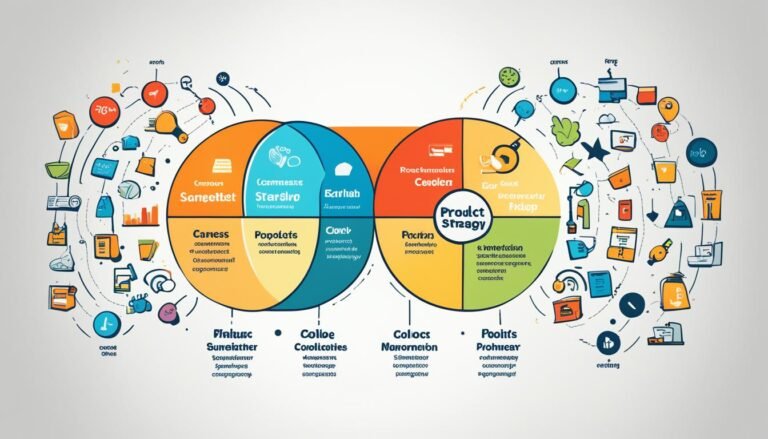The BCG Matrix: Portfolio Analysis for Growth
Did you know the BCG growth share matrix was once used by about half of all Fortune 500 companies? The Boston Consulting Group introduced it in 1970. This tool changed how companies manage their products. It puts products into four groups—Stars, Cash Cows, Question Marks, and Dogs.
This makes it easy for companies to decide where to put their resources. The BCG growth share matrix turns complex decisions into clear actions. For example, Apple’s iPhone was a star product in 2023, making $200.58 billion. But the iPad was a Dog, with sales dropping to $28.3 billion.
These examples show how the matrix helps businesses see where to focus for growth and profit.
Key Takeaways
- The BCG growth share matrix puts products into four groups: Stars, Cash Cows, Question Marks, and Dogs, based on market growth and share.
- At its peak, nearly half of all Fortune 500 companies used it.
- Apple’s 2023 products show how the BCG Matrix works in real life.
- This matrix helps with planning and managing a company’s portfolio.
- Knowing where products stand in the matrix helps in using resources wisely.
Understanding the BCG Matrix
The BCG Matrix, also known as the Boston Consulting Group Matrix, has been key in strategic planning since the 1970s. Bruce Henderson created it for the Boston Consulting Group. It puts products or business units into four groups based on market growth and their share in the market.
These groups are Stars, Cash Cows, Question Marks, and Dogs. They help with analyzing market share and making strategic decisions. This makes it easier for companies to grow.
History and Origin
In the 1970s, Bruce Henderson, a strategic consulting leader, came up with the BCG Matrix. He wanted a way to help companies manage their products better. By looking at market growth and market share, companies could see where to put their resources.
Over time, this method has helped many companies make better investment choices and grow.
Purpose and Importance
The main goal of the BCG Matrix is to help companies make smart strategic plans. It puts products into four groups: Stars, Cash Cows, Question Marks, and Dogs. This lets companies know which products to focus on, which to make money from, and which to stop.
This makes complex data easier to understand. It helps companies use their resources better to grow. Using the BCG Matrix with other tools like SWOT analysis gives a full view of a company’s strategy.
How to Build the BCG Matrix
Building a BCG Matrix means setting up a systematic way to look at how products or business units are doing. It uses competitive analysis, business portfolio management, and product lifecycle planning to help make big decisions.
Setting Up the Grid
The BCG Matrix starts with a two-dimensional grid. The vertical axis shows the market growth rate. This is figured out by:
(Product’s sales this year – Product’s sales last year) / Product’s sales last year
The horizontal axis looks at the relative market share. This is done by:
Product’s sales this year / Leading competitor’s sales this year
This grid puts products into four main groups: Stars, Cash Cows, Question Marks, and Dogs. These groups help a lot with business portfolio management. They show the need for different strategies for different products.
Plotting Products on the Matrix
After setting up the grid, the next step is to plot the products based on their market performance. This starts with looking at each product’s sales to see their growth rate and market share. Here’s how:
- Stars: High growth, high market share. These products lead in growing markets and need a lot of resources and marketing.
- Cash Cows: Low growth, high market share. These products make a lot of money and need little investment.
- Question Marks: High growth, low market share. These products could grow big but need a lot of investment to get there.
- Dogs: Low growth, low market share. These products don’t make much money and might need to be looked at closely for their future.
Adding product lifecycle planning is key. It connects the BCG Matrix to the different stages a product goes through, from new to old. This helps in deciding where to put resources and aligns with goals for business growth.
Quadrant Analysis: Stars
Stars are in the upper-left quadrant of the BCG Matrix. They are high-growth products with a big market share. These products lead the market and need a lot of investment to stay ahead and grow more.
Characteristics of Stars
Stars shine bright in fast-growing markets. They are key products for a company, taking a big chunk of the market. Even though they make a lot of money, they still need a lot of investment to stay ahead.
- High Market Growth: Stars grow quickly, offering more chances to expand.
- Strong Market Share: They are leaders in the market, often setting the trends.
- Capital Intensive: Keeping their top spot requires a lot of money for marketing and research.
Examples of Stars in the Market
Apple’s iPhone is a great example of a Star. It’s known for its innovation and big market share. Apple spends a lot on research and marketing to keep leading the market.
Tesla’s Model 3 is another Star. It’s a top electric vehicle with advanced technology and high demand. Tesla keeps investing to help it grow.
Managing Stars means balancing their ability to make money and investing in them. This way, companies can keep these leading products ahead and bring long-term success.
Quadrant Analysis: Cash Cows
Cash Cows are in the lower left quadrant of the BCG Matrix. They have a big market share in slow-growing industries. These products are stable and reliable, making a steady cash flow. They are often the top players in their markets.
Characteristics of Cash Cows
Cash Cows have some key traits:
- High Market Share: They lead their sectors, often selling more than others.
- Low Market Growth: Their industries grow little, offering few new chances for growth.
- Steady Cash Flow: These products make consistent cash that covers their upkeep costs.
- Minimal Investment Requirement: Being well-known, Cash Cows need little extra money to keep going.
Maximizing Cash Flow from Cash Cows
To make the most of Cash Cows, focus on their profits and sustainability. Here are ways to reinvest:
- Reduce Costs: Make operations lean to cut down on spending, increasing profits.
- Market Penetration: Improve marketing and strengthen brand loyalty to grow market share.
- Diversify Portfolio: Use the cash to invest in new products in fast-growing markets.
Apple’s MacBook is a great example. It leads in the PC market but in a slow-growing sector. By making the most of these products, companies can support and grow their future projects.
Quadrant Analysis: Question Marks
Question Marks are in the upper right quadrant of the BCG Matrix. They show products with high growth but low market share. These products have big potential but their future is unsure. Companies must decide if investing in them is worth it.
It’s key to carefully evaluate these products. Testing the market can show which ones are worth investing in. For example, Apple’s Apple TV service is a Question Mark in the streaming market. It’s growing fast but has a small share. Apple needs to invest a lot to get a bigger piece of the market.
Managing Question Marks well means using resources wisely. Companies must think about how much to invest in each product. They should keep testing the market and evaluating their business strategies. This helps make sure their investments pay off.
The goal is to turn Question Marks into Stars. Companies need to stay alert and keep testing the market. This way, they can make the most of their investments and keep their product line strong.
Quadrant Analysis: Dogs
*Dogs* are in the lower right quadrant of the BCG Matrix. They have low market growth and share. These products just make enough money to keep going but don’t make much profit.
Characteristics of Dogs
Dogs, or low-growth products, have certain traits. They are in a market that grows slowly and have a small share compared to others. They don’t need much investment to stay in the game but won’t likely become big leaders.
These products usually don’t make much money or might even lose money. If not handled right, they can hurt the company’s overall performance.
Strategies for Managing Dogs
Managing Dogs well means making tough choices. Key strategies include *market divestiture*, repositioning, or *product phasing out*. Often, companies sell off or close these products since they don’t fit their strategy.
In some cases, repositioning might work if the product can help other brands. For example, Apple’s iPad sales are dropping, making it a *Dog*. This might mean they need to sell it or stop making it to focus on more profitable areas.
Real-World Applications of the BCG Matrix
The BCG Matrix has changed how companies plan their strategies. It helps them understand how well products are doing and where to invest. We can see its impact with companies like Apple Inc.
Case Study: Apple Inc.
Apple Inc. is a great example of using the BCG Matrix. They look at their products like this:
- iPhone: It’s a Star because it’s very popular in a growing market. Apple keeps investing in it to stay ahead.
- MacBook: This is a Cash Cow. It makes a lot of money in a stable market with little need for extra investment.
- Apple TV: It’s a Question Mark. It’s in a growing market but doesn’t have much share. Apple needs to invest a lot to improve its position.
- iPad: This is a Dog. It has a small market share in a slow-growing market. Apple is deciding if it should keep it or not.
Lessons Learned from Real-World Applications
The BCG Matrix gives companies big wins. By looking at Apple, we learn how to manage products well. Key lessons are:
The BCG Matrix helps with deciding where to put resources and how to position in the market. For example, Tesla Motors turned Question Marks into Stars, showing how well they used the BCG Matrix.
Brands like Samsung and Unilever also did well. They balanced their products and brands for growth. The BCG Matrix has four parts – Stars, Cash Cows, Question Marks, and Dogs. Each one has its own strategy for using resources and staying competitive.
Advantages of Using the BCG Matrix
The BCG Matrix makes managing a company’s products easier. It helps in deciding where to put resources for the best return. By looking at products through the matrix, companies can see where to focus for the most gain.
This tool also helps in picking which markets to focus on. It puts products into four groups: Stars, Cash Cows, Question Marks, and Dogs. This way, companies know which products to invest in, keep, or drop.
Using the BCG Matrix in strategic planning helps analyze business units deeply. It shows which products are doing well and where growth is highest. This makes decisions clearer and easier to see, thanks to its visual format.
Many big companies, like those in the Fortune 500, use the BCG Matrix. It’s simple yet powerful, helping with cash flow and investment choices. So, companies that use it often manage their money better and make smarter investment moves.
The BCG Matrix can also work with other strategies. For example, combining it with SWOT analysis gives deeper insights into what affects product success. This helps companies stay ahead by making smart, informed choices.
Limitations and Criticisms of the BCG Matrix
The BCG Matrix is a useful tool, but it has its downsides. A big issue is that it oversimplifies market dynamics. Critics say it doesn’t consider important factors, leading to solutions that might not work everywhere.
Even though it’s widely used, the BCG Matrix focuses too much on market share and growth rate. This overlooks the complexity and cost of increasing market share. It also ignores midsize businesses, which are key in many industries.
Market analysis critique shows the BCG Matrix has its limits. It relies too much on market share and growth rates, missing other key business health metrics like profitability and stability. This can give a wrong view of a company’s competitive edge and future.
The BCG Matrix also doesn’t handle portfolio management challenges well. Managing a mix of business units is complex, and this model doesn’t capture that. It doesn’t consider how units might work together or the effect of new competitors. This can make strategic planning and resource use less effective.
In conclusion, the BCG Matrix is simple to use for portfolio analysis, but it has big limitations. Its strategic planning limitations and lack of detail in market dynamics and portfolio management are clear. Using it with other tools gives a fuller view of a company’s strategy.
How the BCG Matrix Influences Strategic Planning
The BCG Matrix is a key tool for strategic decision making in businesses. It sorts products by market growth and share. This helps companies know where to put their resources best. It tells which products need more money, which are doing well, and which should be sold.
Decision Making
The BCG Matrix is vital for making strategic choices. It looks at market growth and share to put products into Stars, Cash Cows, Question Marks, or Dogs. Knowing where a product fits helps decide its future.
- Stars: These are products growing fast and leading in the market. They need a lot of investment to keep growing.
- Cash Cows: These products don’t grow much but are leaders in the market. They make a lot of money with little investment.
- Question Marks: These products have a small share in fast-growing markets. Companies must think hard about investing in them.
- Dogs: These products grow slowly and have a small share. They usually don’t get more investment and might be sold.
This method makes sure decisions match the company’s goals. It helps improve both short-term and long-term success.
Resource Allocation
The BCG Matrix also guides in using resources well. By knowing which products are Stars, Cash Cows, Question Marks, or Dogs, companies can use their money and people better. Here are some important points:
- Investing in Stars: Putting more resources into Stars helps them grow and stay competitive.
- Using Cash Cows wisely: The cash from Cash Cows can fund growth in other areas.
- Reviewing Question Marks: Only investing in Question Marks that have a good chance of success.
- Letting go of Dogs: Moving resources from Dogs to better opportunities helps the business grow.
Using the BCG Matrix for business investment strategies and financial planning in business helps companies plan better. It ensures resources are used for growth and profit.
Applying the BCG Matrix in Digital Marketing
The BCG Matrix is a great tool for digital marketing. It puts online channels into four main groups: Stars, Cash Cows, Question Marks, and Dogs. By sorting channels by their success and growth, marketers can make their digital marketing better and get a higher return on investment.
Marketing Channels and the Matrix
The framework sorts marketing channels like products do:
- Stars: These are top channels like Google Ads or Facebook Ads. They bring in a lot of money and need regular investment to stay ahead.
- Cash Cows: These are channels that have been around for a while, like email marketing. They make steady money with little effort, which helps pay for new projects.
- Question Marks: These are new channels like TikTok Ads. They have a lot of potential but need careful planning to grow their market share.
- Dogs: These are channels that don’t do well, like old banner ads. They might need to be changed or stopped because they don’t make enough money.
Optimizing Digital Strategies
Using the BCG Matrix is key to getting the best results from your digital marketing. Here’s how to use it to improve your online marketing:
- Invest in Stars: Put money into channels that are doing great. These are your top earners that need ongoing support to stay on top.
- Maximize returns from Cash Cows: Use reliable channels to make a lot of money with little effort. This helps balance your budget for new and risky projects.
- Carefully evaluate Question Marks: Look closely at channels with big growth potential. They need a lot of investment and careful planning to become Stars.
- Divest Dogs: Spend less on channels that don’t do much. Use the money for better opportunities.
Using the BCG Matrix well can give deep insights for improving digital marketing. It helps find out which channels need more money and which ones should change. This can take your digital presence to new heights.
Integrating the BCG Matrix with Other Business Tools
For businesses looking to strengthen their strategy, combining the BCG Matrix with other tools is key. The BCG Matrix shows growth and market share. Adding SWOT analysis integration and lifecycle analysis makes strategies more detailed and comprehensive.
Combining with SWOT Analysis
Linking the BCG Matrix with SWOT analysis gives a full view of a company’s strengths and market conditions. The BCG Matrix shows where products stand in the market. SWOT analysis adds the factors that affect these positions. This mix helps companies:
- Leverage strengths to keep Stars in leading positions by investing more.
- Address weaknesses in Question Marks by finding growth strategies and market chances.
- Identify opportunities for Cash Cows to make more money, funding other areas.
- Analyze threats to Dogs and decide on their future.
This blend helps in making comprehensive strategy development. It helps companies handle market changes and competition better.
Using with the Product Lifecycle
Pairing the BCG Matrix with the product lifecycle is also powerful. Each product life stage—introduction, growth, maturity, and decline—matches the BCG Matrix quadrants. For example:
- Introduction Phase: Fits with Question Marks, products in growing markets with low shares, needing growth checks.
- Growth Phase: Products turn into Stars, needing big investments to keep market share in growing markets.
- Maturity Phase: Products become Cash Cows, making money in stable markets.
- Decline Phase: Products move to Dogs, showing a need to cut or make the most of what’s left.
Combining lifecycle analysis with the BCG Matrix gives businesses clear insights. It helps in making investments and strategies based on the product’s stage and market. This approach leads to a smart way of comprehensive strategy development, making the most of each product.
Conclusion
The BCG Matrix is a key tool for strategic planning. It helps businesses analyze growth and manage their portfolios well. Created in the 1960s by the Boston Consulting Group, it sorts business units into four groups: Stars, Cash Cows, Question Marks, and Dogs.
This tool guides companies on where to invest for the best returns and where to cut losses. It uses a five-step process for analysis and decision-making.
Even with its limits, the BCG Matrix is still a powerful tool for managing portfolios. It helps focus on promising projects, reduce risks, meet strategic goals, and improve communication. By sorting products into different categories, companies can make smart choices that fit the market.
The BCG Matrix is simple yet powerful for those looking to grow their businesses. It may oversimplify some market situations, but its core ideas are very useful. When combined with other tools, it helps companies deal with business challenges and succeed over time.
Source Links
- Understanding the BCG Growth Share Matrix and How to Use It
- Boston Consulting Group (BCG) Matrix
- Introduction to the BCG matrix
- BCG Matrix in Strategic Management: A Guide to Portfolio Analysis and Decision-Making | Creately
- BCG Matrix: Examples and How to Use It | SafetyCulture
- What Is BCG Matrix? – Examples & How-To Guide
- BCG Matrix – Definition, How to Use, Formula & Example
- How to Use a BCG Matrix
- How to use the BCG Matrix | Smart Insights Digital Marketing
- What is the BCG Matrix? Explaining its Components and Quadrants
- Project Management Glossary: portfolio or BCG matrix
- Boston Consulting Group (BCG) Growth-Share Matrix – SM Insight
- 14 BCG Matrix Examples to Unlock Growth Opportunities | Creately
- Mastering the BCG Matrix: Examples and Usage Guide – DataMyte
- What is a BCG matrix? Example, Advantages, Limitations
- What Is the Boston Consulting Group Growth-share Matrix? Benefits, Alternatives and FAQs
- BCG Matrix
- BCG Matrix – Meaning and its Limitations
- Limitations of the BCG Matrix –
- The BCG Matrix Explained – How Does the BCG Matrix Work?
- BCG Matrix EXPLAINED with EXAMPLES | B2U | Business-to-you.com
- Understanding the BCG Growth Share Matrix and How to Use It
- BCG Matrix – Learn How To Use With Examples
- Portfolio Management: BCG Matrix and GE-McKinsey Matrix – Business Strategy and Policy Study Guide 2024 | Fiveable
- BCG Matrix
- The BCG Matrix in Project Management
- Summary of the BCG Matrix. Abstract







